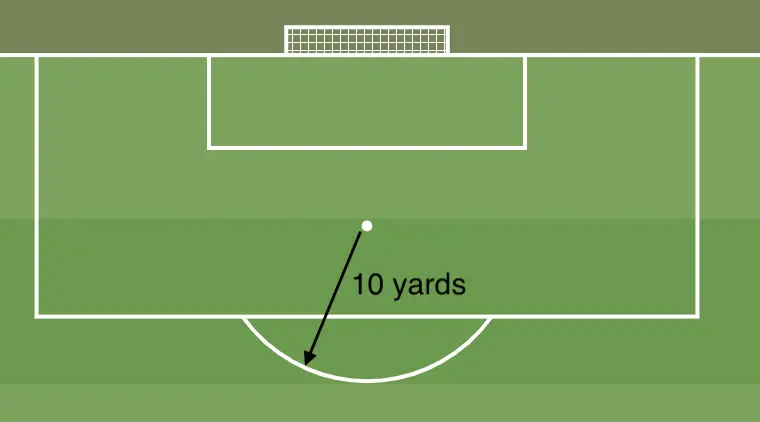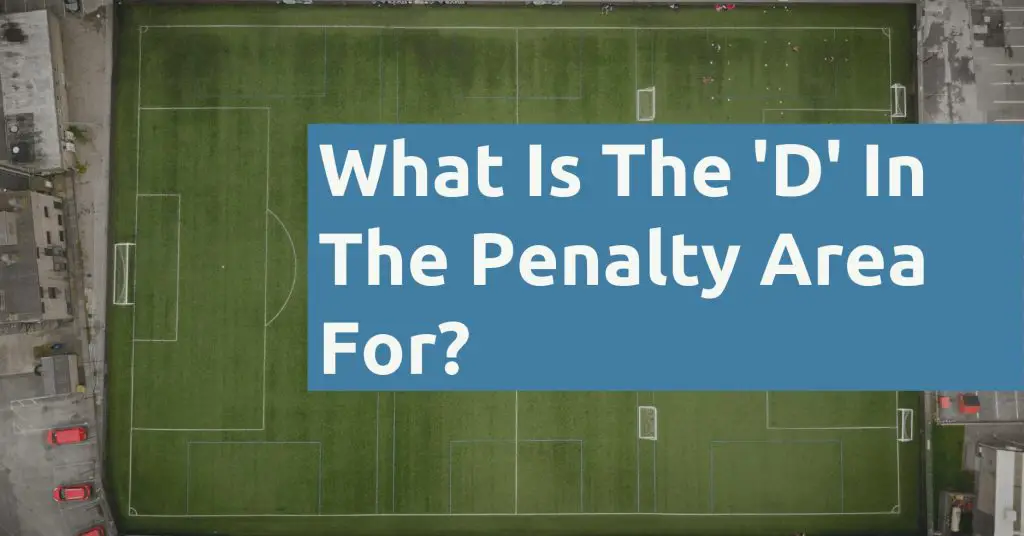Last updated on June 14th, 2021
You may have seen the half circle at the edge of the penalty box. Did you know that it actually has a purpose?
I did not really think much about the penalty arc until searching more about it!
Here’s what you need to know about that curved area around the penalty box in football:
Contents
What is the ‘D’ in the penalty area for?
The D-shaped area is the penalty arc that marks a 10 yard boundary around the penalty spot. All players except for the penalty taker and the goalkeeper cannot cross into this arc before a penalty kick is being taken.
So why exactly is this boundary being put in place?
The 3 main areas involved in a penalty
Before explaining further, there are actually 3 main areas on the pitch you’ll need to take note of for a penalty:
- Penalty area
- Penalty mark (or spot)
- Penalty arc

You may be familiar with the term ‘penalty spot’. However, the Laws of the Game call it the penalty mark!
These terms are useful to interpret what the Laws of the Game says.
Players cannot be within 10 yards of the penalty spot
When a penalty is being taken, the Laws of the Game states that all players other than the kicker and goalkeeper must be:
- At least 9.15 m (10 yds) from the penalty mark
- Behind the penalty mark
- Inside the field of play
- Outside the penalty area
When all of the players are away from the penalty area, the penalty kick can then be taken.
For the first point, the penalty mark is referring to the penalty spot. This rule is why you see the penalty arc!
The penalty arc marks the 10 yard radius from the penalty spot.

If you continue drawing the circle, you will get a full circle with the penalty mark at the centre. The radius of this circle will be 10 yards.
This means that if the players enter the penalty arc, they will be within 10 yards of the penalty mark!
Depending on who makes the infringement, the referee may call for a retake or an indirect free kick.
Moreover, any player except for the penalty kicker and the goalkeeper cannot step into the penalty area. If they do so, there will be an infringement as well.
This is because the Laws also state that these players have to be outside of the penalty area too.
This is why the penalty arc is only half a circle. It only needs to create a boundary for the part that is not already covered by the penalty area.
There is no need to mark out the entire circle around the penalty spot!
Why is the penalty arc important?
The penalty arc helps to prevent any player that is not the penalty kicker or the goalkeeper from having an unfair advantage once the ball is played. All players will be an equal distance from the penalty mark, no matter where they are standing.
The Laws of the Game usually have rules which maintains the minimum distances. This is similar to the laws governing a free kick:
Until the ball is in play all opponents must remain at least 9.15 m (10 yds) from the ball, unless they are on their own goal line between the goalposts
IFAB
For a penalty, the ball is placed on the penalty mark (or spot). To maintain the 10 yard distance from the ball, the penalty arc is used to demarcate this distance.
This helps the referee to easily see who is committing an offence!
The players only have to remain in this position before the ball is in play. Once the ball is kicked by the penalty kicker, all players are able to rush into the penalty area.
However if a player rushes into the penalty arc before the ball is kicked by the penalty kicker, a foul will occur.
If the goalkeeper dives the wrong way during the penalty, then it may not really matter if the players rush in or not.
The penalty arc prevents players who are directly behind the ball to gain an unfair advantage.
No matter where they stand, they cannot be closer to the penalty mark unless they encroach into the penalty arc!
Is the ‘D’ part of the penalty area?
The ‘D’-shaped area (penalty arc) is not part of the penalty area. The penalty arc only demarcates the 10 yard radius from the penalty spot. The penalty arc only adjoins the penalty area but is not considered to be part of it.
Can a goalie use his hands in the penalty arc?
A goalkeeper cannot use his hands in the penalty arc. This is because the goalkeeper can only use his hands in the penalty area, and the penalty arc is not a part of the penalty area.
According to Law 12, a goalkeeper can only handle the ball inside his own penalty area. If the goalkeeper touches the ball with his hands in the penalty arc, it will be considered as outside the penalty area.
As such, a foul will be called and a free kick might be awarded to the opposing team!
This is because the penalty arc is only significant during a penalty kick. In all other scenarios, the penalty arc does not affect the play in any way!
Conclusion
The penalty arc is only important during a penalty kick. It is used to demarcate the 10 yard boundary from the penalty spot, which is outside of the penalty area.
This helps to prevent any player from gaining an unfair advantage once the ball is kicked, especially if there is a rebound!
However, the penalty arc is not a part of the penalty area. As such, the goalkeeper can only use his hands in the 18 yard box!
Subscribe to Telegram and Twitter to get the latest updates!

Are you passionate about football and want to earn some side income?

